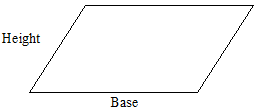5.11: Unknown Dimensions of Parallelograms
- Page ID
- 4995
\( \newcommand{\vecs}[1]{\overset { \scriptstyle \rightharpoonup} {\mathbf{#1}} } \)
\( \newcommand{\vecd}[1]{\overset{-\!-\!\rightharpoonup}{\vphantom{a}\smash {#1}}} \)
\( \newcommand{\dsum}{\displaystyle\sum\limits} \)
\( \newcommand{\dint}{\displaystyle\int\limits} \)
\( \newcommand{\dlim}{\displaystyle\lim\limits} \)
\( \newcommand{\id}{\mathrm{id}}\) \( \newcommand{\Span}{\mathrm{span}}\)
( \newcommand{\kernel}{\mathrm{null}\,}\) \( \newcommand{\range}{\mathrm{range}\,}\)
\( \newcommand{\RealPart}{\mathrm{Re}}\) \( \newcommand{\ImaginaryPart}{\mathrm{Im}}\)
\( \newcommand{\Argument}{\mathrm{Arg}}\) \( \newcommand{\norm}[1]{\| #1 \|}\)
\( \newcommand{\inner}[2]{\langle #1, #2 \rangle}\)
\( \newcommand{\Span}{\mathrm{span}}\)
\( \newcommand{\id}{\mathrm{id}}\)
\( \newcommand{\Span}{\mathrm{span}}\)
\( \newcommand{\kernel}{\mathrm{null}\,}\)
\( \newcommand{\range}{\mathrm{range}\,}\)
\( \newcommand{\RealPart}{\mathrm{Re}}\)
\( \newcommand{\ImaginaryPart}{\mathrm{Im}}\)
\( \newcommand{\Argument}{\mathrm{Arg}}\)
\( \newcommand{\norm}[1]{\| #1 \|}\)
\( \newcommand{\inner}[2]{\langle #1, #2 \rangle}\)
\( \newcommand{\Span}{\mathrm{span}}\) \( \newcommand{\AA}{\unicode[.8,0]{x212B}}\)
\( \newcommand{\vectorA}[1]{\vec{#1}} % arrow\)
\( \newcommand{\vectorAt}[1]{\vec{\text{#1}}} % arrow\)
\( \newcommand{\vectorB}[1]{\overset { \scriptstyle \rightharpoonup} {\mathbf{#1}} } \)
\( \newcommand{\vectorC}[1]{\textbf{#1}} \)
\( \newcommand{\vectorD}[1]{\overrightarrow{#1}} \)
\( \newcommand{\vectorDt}[1]{\overrightarrow{\text{#1}}} \)
\( \newcommand{\vectE}[1]{\overset{-\!-\!\rightharpoonup}{\vphantom{a}\smash{\mathbf {#1}}}} \)
\( \newcommand{\vecs}[1]{\overset { \scriptstyle \rightharpoonup} {\mathbf{#1}} } \)
\( \newcommand{\vecd}[1]{\overset{-\!-\!\rightharpoonup}{\vphantom{a}\smash {#1}}} \)
\(\newcommand{\avec}{\mathbf a}\) \(\newcommand{\bvec}{\mathbf b}\) \(\newcommand{\cvec}{\mathbf c}\) \(\newcommand{\dvec}{\mathbf d}\) \(\newcommand{\dtil}{\widetilde{\mathbf d}}\) \(\newcommand{\evec}{\mathbf e}\) \(\newcommand{\fvec}{\mathbf f}\) \(\newcommand{\nvec}{\mathbf n}\) \(\newcommand{\pvec}{\mathbf p}\) \(\newcommand{\qvec}{\mathbf q}\) \(\newcommand{\svec}{\mathbf s}\) \(\newcommand{\tvec}{\mathbf t}\) \(\newcommand{\uvec}{\mathbf u}\) \(\newcommand{\vvec}{\mathbf v}\) \(\newcommand{\wvec}{\mathbf w}\) \(\newcommand{\xvec}{\mathbf x}\) \(\newcommand{\yvec}{\mathbf y}\) \(\newcommand{\zvec}{\mathbf z}\) \(\newcommand{\rvec}{\mathbf r}\) \(\newcommand{\mvec}{\mathbf m}\) \(\newcommand{\zerovec}{\mathbf 0}\) \(\newcommand{\onevec}{\mathbf 1}\) \(\newcommand{\real}{\mathbb R}\) \(\newcommand{\twovec}[2]{\left[\begin{array}{r}#1 \\ #2 \end{array}\right]}\) \(\newcommand{\ctwovec}[2]{\left[\begin{array}{c}#1 \\ #2 \end{array}\right]}\) \(\newcommand{\threevec}[3]{\left[\begin{array}{r}#1 \\ #2 \\ #3 \end{array}\right]}\) \(\newcommand{\cthreevec}[3]{\left[\begin{array}{c}#1 \\ #2 \\ #3 \end{array}\right]}\) \(\newcommand{\fourvec}[4]{\left[\begin{array}{r}#1 \\ #2 \\ #3 \\ #4 \end{array}\right]}\) \(\newcommand{\cfourvec}[4]{\left[\begin{array}{c}#1 \\ #2 \\ #3 \\ #4 \end{array}\right]}\) \(\newcommand{\fivevec}[5]{\left[\begin{array}{r}#1 \\ #2 \\ #3 \\ #4 \\ #5 \\ \end{array}\right]}\) \(\newcommand{\cfivevec}[5]{\left[\begin{array}{c}#1 \\ #2 \\ #3 \\ #4 \\ #5 \\ \end{array}\right]}\) \(\newcommand{\mattwo}[4]{\left[\begin{array}{rr}#1 \amp #2 \\ #3 \amp #4 \\ \end{array}\right]}\) \(\newcommand{\laspan}[1]{\text{Span}\{#1\}}\) \(\newcommand{\bcal}{\cal B}\) \(\newcommand{\ccal}{\cal C}\) \(\newcommand{\scal}{\cal S}\) \(\newcommand{\wcal}{\cal W}\) \(\newcommand{\ecal}{\cal E}\) \(\newcommand{\coords}[2]{\left\{#1\right\}_{#2}}\) \(\newcommand{\gray}[1]{\color{gray}{#1}}\) \(\newcommand{\lgray}[1]{\color{lightgray}{#1}}\) \(\newcommand{\rank}{\operatorname{rank}}\) \(\newcommand{\row}{\text{Row}}\) \(\newcommand{\col}{\text{Col}}\) \(\renewcommand{\row}{\text{Row}}\) \(\newcommand{\nul}{\text{Nul}}\) \(\newcommand{\var}{\text{Var}}\) \(\newcommand{\corr}{\text{corr}}\) \(\newcommand{\len}[1]{\left|#1\right|}\) \(\newcommand{\bbar}{\overline{\bvec}}\) \(\newcommand{\bhat}{\widehat{\bvec}}\) \(\newcommand{\bperp}{\bvec^\perp}\) \(\newcommand{\xhat}{\widehat{\xvec}}\) \(\newcommand{\vhat}{\widehat{\vvec}}\) \(\newcommand{\uhat}{\widehat{\uvec}}\) \(\newcommand{\what}{\widehat{\wvec}}\) \(\newcommand{\Sighat}{\widehat{\Sigma}}\) \(\newcommand{\lt}{<}\) \(\newcommand{\gt}{>}\) \(\newcommand{\amp}{&}\) \(\definecolor{fillinmathshade}{gray}{0.9}\)Use formula \(A = bh\) to solve for unknown variable

Michael is in charge of designing a banner for the school’s Homecoming activities. The banner will be divided into 4 different colored parallelograms each representing a different grade. The banner’s quilt-style design requires each of the parallelograms to have an area of at least 720 square inches and a base of 36 inches. How can Michael use this information to determine the minimal height of each parallelogram?
In this concept, you will learn how to find unknown dimensions of parallelograms given the area and another dimension.
Finding Unknown Dimensions of Parallelograms
Finding the missing dimensions in parallelograms requires you to work backwards. You can figure out a missing dimension if you have been given the area and another measurement, such as the area and the height or the area and the base.
The area of a parallelogram is determined by multiplying the base and the height.

\(\text{ Base} \times \text{ Height }= \text{ Area of a parallelogram}\)
If you know the area and the base or the area and height, you can use this formula and division to find the missing dimension.
Let’s begin with a parallelogram where the base is the missing dimension.
A parallelogram has an area of 48 square inches and a height of 6 inches. What is the measurement of the base?
First, substitute the known information into the formula for computing the area of a parallelogram.
\(\begin{aligned} \text{ Base} \times \text{ Height } &= \text{ Area of a parallelogram} \\ \text{ Base }\times 6 \text{ inches } &=48\text{ square inches } \end{aligned}\)
Next, to get the base by itself on one side of the equal sign, divide both sides by the known height, 6 inches.
\(\dfrac{\text{ Base } (6\text{ inches })}{6\text{ inches }}=\dfrac{48\text{ square inches }}{6\text{ inches }}\)
On the left side of the equation, the 6 inches will cancel leaving the base. On the right side of the equation 48 square inches are divided by 6 inches, leaving 8 inches.
Base = 8 inches
The answer is the base is 8 inches.
To find the missing base, you simply divided the area by the given height. This will work the same way if you are looking for the height. To find the missing height, divide the area by the given base.
Consider this parallelogram where height is the missing dimension.
A parallelogram has an area of 54 square feet and a base of 9 feet. What is the height of the parallelogram?
Start by working backwards.
To find the missing height, divide the given area by the given base measurement.
\(54\div 9=6\)
The height of the parallelogram is 6 feet.
Example \(\PageIndex{1}\)
Earlier, you were given a problem about Michael and the Homecoming banner.
The banner will hang at the entrance of the school during the week of Homecoming, so Michael wants to make sure each class is represented equally on the banner. Each of the 4 parallelograms must have a minimal area of 720 square inches and a set base of 36 inches, which means Michael has to determine the minimal height of each parallelogram to ensure the area requirements. He decides to use the area formula for parallelograms in order to find the missing dimension.
Solution
First, he substitutes the known information into the formula for computing the area of a parallelogram.
\(\begin{aligned} \text{ Base} \times \text{ Height } &= \text{ Area of a parallelogram} \\ 36\text{ inches }\times \text{ Height } &= 720 \text{ square inches } \end{aligned}\)
Next, to get the base by itself on one side of the equal sign, divide both sides by the known height, 6 inches.
\(\dfrac{(36\text{ inches })\text{ Height}}{36 \text{ inches }}=\dfrac{720 \text{ square inches }}{36 \text{ inches}}\)
Notice, that Michael divided the given area by the given base to find the missing height.
\(720\div 36=20\)
\(\text{ Height} = 20\text{ inches }\)
The answer is the minimal height of the parallelograms must be 20 inches.
Example \(\PageIndex{2}\)
Find the parallelogram’s missing dimension.
The area of the parallelogram is 169 square inches. The length of the base is 13 inches. What is the height?
Solution
First, substitute the known information into the formula for computing the area of a parallelogram.
\(\begin{aligned} \text{ Base} \times \text{ Height } &= \text{ Area of a parallelogram} \\ 13\text{ inches }\times \text{ Height } &=169 \text{ square inches } \end{aligned} \)
Next, to get the base by itself on one side of the equal sign, divide both sides by the known height, 6 inches.
\(\dfrac{(13\text{ inches }) \text{ Height }}{13\text{ inches }}=\dfrac{169\: \text{ square inches }}{13\text{ inches }}\)
Notice, that you simply divided the given area by the given base to find the missing height.
\(169\div 13=13\)
\(\text{ Height }= 13\text{ inches }\)
The answer is the height is 13 inches.
Example \(\PageIndex{3}\)
Find the parallelogram's missing dimension using the given measurements.
Area = 25 square meters
Base = 5 meters
Solution
First, divide the given area by the given base to find the missing height.
\(25\div 5=5\)
\(\text{ Height }= 5\: meters\)
The answer is the height is 5 meters.
Example \(\PageIndex{4}\)
Find the parallelogram's missing dimension using the given measurements.
Area = 81 square feet
Base = 27 feet
Solution
First, divide the given area by the given base to find the missing height.
\(81\div 27=3\)
\(\text{ Height }= 3 \text{ feet }\)
The answer is the height is 3 feet.
Example \(\PageIndex{5}\)
Find the parallelogram's missing dimension using the given measurements.
Area = 36 square inches
Height = 2 inches
Solution
First, divide the given area by the given height to find the missing base.
\(36\div 2=18\)
\(\text{ Height }= 18\text{ inches }\)
The answer is the height is 18 inches.
Review
Use the given area and other dimension to find the missing base or height.
- Area = 22 sq. inches, Base = 11 inches
- Area = 50 sq. miles, Base = 10 miles
- Area = 48 sq. inches, Base = 8 inches
- Area = 30 sq. meters, Base = 15 meters
- Area = 45 sq. feet, Height = 3 feet
- Area = 88 sq. feet, Height = 8 feet
- Area = 121 sq. feet, Height = 11 feet
- Area = 160 sq. miles, Height = 20 miles
- Area = 90 sq. meters, Height = 30 meters
- Area = 100 sq. feet, Base = 25 feet
- Area = 120 sq. feet, Base = 20 feet
- Area = 144 sq. feet, Base = 12 feet
- Area = 200 sq. feet, Base = 20 feet
- Area = 400 sq. feet, Base = 200 feet
- Area = 360 sq. feet, Base = 100 feet
Review (Answers)
To see the Review answers, open this PDF file and look for section 10.2.
Vocabulary
| Term | Definition |
|---|---|
| Area | Area is the space within the perimeter of a two-dimensional figure. |
| Rectangle | A rectangle is a quadrilateral with four right angles. |
Additional Resources
Video: Area of a Parallelogram (Whole Numbers)
Practice: Unknown Dimensions of Parallelograms

